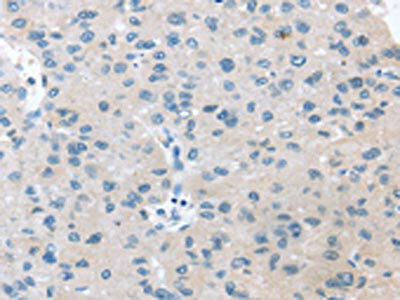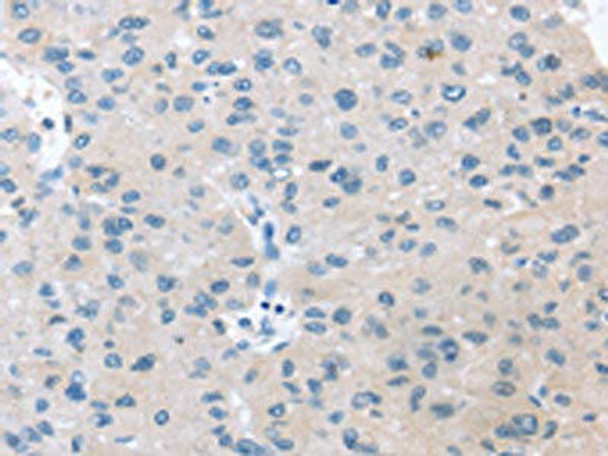Description
| Antibody Name: | VPS4B Antibody (PACO20863) |
| Antibody SKU: | PACO20863 |
| Size: | 50ul |
| Host Species: | Rabbit |
| Tested Applications: | ELISA, IHC |
| Recommended Dilutions: | ELISA:1:1000-1:2000, IHC:1:10-1:50 |
| Species Reactivity: | Human |
| Immunogen: | Synthetic peptide of human VPS4B |
| Form: | Liquid |
| Storage Buffer: | -20°C, pH7.4 PBS, 0.05% NaN3, 40% Glycerol |
| Purification Method: | Antigen affinity purification |
| Clonality: | Polyclonal |
| Isotype: | IgG |
| Conjugate: | Non-conjugated |
 | The image on the left is immunohistochemistry of paraffin-embedded Human liver cancer tissue using PACO20863(VPS4B Antibody) at dilution 1/20, on the right is treated with synthetic peptide. (Original magnification: x200). |
| Background: | The protein encoded by this gene is a member of the AAA protein family (ATPases associated with diverse cellular activities), and is the homolog of the yeast Vps4 protein. In humans, two paralogs of the yeast protein have been identified. The former share a high degree of aa sequence similarity with each other, and also with yeast Vps4 and mouse Skd1 proteins. Mouse Skd1 (suppressor of K+ transport defect 1) has been shown to be a yeast Vps4 ortholog. Functional studies indicate that both human paralogs associate with the endosomal compartments, and are involved in intracellular protein trafficking, similar to Vps4 protein in yeast. The gene encoding this paralog has been mapped to chromosome 18; the gene for the other resides on chromosome 16. |
| Synonyms: | vacuolar protein sorting 4 homolog B (S. cerevisiae) |
| UniProt Protein Function: | VPS4B: Involved in late steps of the endosomal multivesicular bodies (MVB) pathway. Recognizes membrane-associated ESCRT-III assemblies and catalyzes their disassembly, possibly in combination with membrane fission. Redistributes the ESCRT-III components to the cytoplasm for further rounds of MVB sorting. MVBs contain intraluminal vesicles (ILVs) that are generated by invagination and scission from the limiting membrane of the endosome and mostly are delivered to lysosomes enabling degradation of membrane proteins, such as stimulated growth factor receptors, lysosomal enzymes and lipids. In conjunction with the ESCRT machinery also appears to function in topologically equivalent membrane fission events, such as the terminal stages of cytokinesis and enveloped virus budding (HIV-1 and other lentiviruses). Belongs to the AAA ATPase family. |
| UniProt Protein Details: | Protein type:Vesicle; EC 3.6.4.6 Chromosomal Location of Human Ortholog: 18q21.33 Cellular Component: spindle pole; centrosome; lysosome; late endosome membrane; vacuolar membrane; early endosome; cytoplasm; late endosome; endosome membrane; nucleus; cytosol; endosome Molecular Function:protein C-terminus binding; protein binding; ATPase activity; ATPase activity, coupled; microtubule-severing ATPase activity; ATP binding Biological Process: ubiquitin-dependent protein catabolic process via the multivesicular body pathway; viral reproduction; endosome organization and biogenesis; cell separation during cytokinesis; intracellular cholesterol transport; regulation of viral reproduction; viral infectious cycle; endosome transport; response to lipid; protein depolymerization; mitotic metaphase plate congression; endosome to lysosome transport via multivesicular body sorting pathway; cytoplasmic microtubule organization and biogenesis; protein transport; potassium ion transport; nuclear organization and biogenesis; vacuole organization and biogenesis |
| NCBI Summary: | The protein encoded by this gene is a member of the AAA protein family (ATPases associated with diverse cellular activities), and is the homolog of the yeast Vps4 protein. In humans, two paralogs of the yeast protein have been identified. The former share a high degree of aa sequence similarity with each other, and also with yeast Vps4 and mouse Skd1 proteins. Mouse Skd1 (suppressor of K+ transport defect 1) has been shown to be a yeast Vps4 ortholog. Functional studies indicate that both human paralogs associate with the endosomal compartments, and are involved in intracellular protein trafficking, similar to Vps4 protein in yeast. The gene encoding this paralog has been mapped to chromosome 18; the gene for the other resides on chromosome 16. [provided by RefSeq, Jul 2008] |
| UniProt Code: | O75351 |
| NCBI GenInfo Identifier: | 41019529 |
| NCBI Gene ID: | 9525 |
| NCBI Accession: | O75351.2 |
| UniProt Secondary Accession: | O75351,Q69HW4, Q9GZS7, |
| UniProt Related Accession: | O75351 |
| Molecular Weight: | 444 |
| NCBI Full Name: | Vacuolar protein sorting-associated protein 4B |
| NCBI Synonym Full Names: | vacuolar protein sorting 4 homolog B (S. cerevisiae) |
| NCBI Official Symbol: | VPS4B |
| NCBI Official Synonym Symbols: | MIG1; SKD1; SKD1B; VPS4-2 |
| NCBI Protein Information: | vacuolar protein sorting-associated protein 4B; cell migration-inducing 1; vacuolar protein sorting 4B; suppressor of K+ transport defect 1; cell migration-inducing gene 1 protein; suppressor of K(+) transport growth defect 1 |
| UniProt Protein Name: | Vacuolar protein sorting-associated protein 4B |
| UniProt Synonym Protein Names: | Cell migration-inducing gene 1 protein; Suppressor of K(+) transport growth defect 1; Protein SKD1 |
| Protein Family: | Vacuolar protein sorting-associated protein |
| UniProt Gene Name: | VPS4B |
| UniProt Entry Name: | VPS4B_HUMAN |
| Antibodies |
| Anti-VPS4B Antibody (CAB15758) |
| Secondary Antibody |
| Anti-HRP Goat Anti-Rabbit IgG (H+L) Antibody (CABS014) |
| Recommended Products |
| Anti-FITC Goat Anti-Rabbit IgG (H+L) Antibody (CABS011) |
| Anti-HRP-conjugated Beta Actin Antibody (CABC028) |






